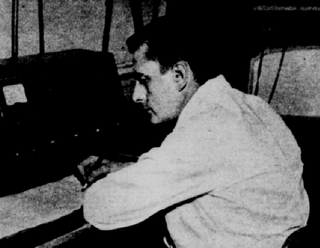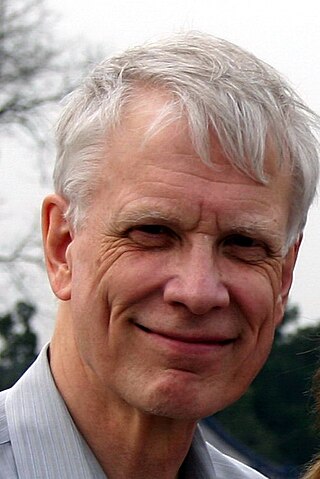Related Research Articles

Parapsychology is the study of alleged psychic phenomena and other paranormal claims, for example, those related to near-death experiences, synchronicity, apparitional experiences, etc. Criticized as being a pseudoscience, the majority of mainstream scientists reject it. Parapsychology has also been criticized by mainstream critics for claims by many of its practitioners that their studies are plausible despite a lack of convincing evidence after more than a century of research for the existence of any psychic phenomena.
Parapsychology is a field of research that studies a number of ostensible paranormal phenomena, including telepathy, precognition, clairvoyance, psychokinesis, near-death experiences, reincarnation, and apparitional experiences.

Telepathy is the purported vicarious transmission of information from one person's mind to another's without using any known human sensory channels or physical interaction. The term was first coined in 1882 by the classical scholar Frederic W. H. Myers, a founder of the Society for Psychical Research (SPR), and has remained more popular than the earlier expression thought-transference.

A psychic is a person who claims to use powers rooted in parapsychology such as extrasensory perception (ESP) to identify information hidden from the normal senses, particularly involving telepathy or clairvoyance, or who performs acts that are apparently inexplicable by natural laws, such as psychokinesis or teleportation. Although many people believe in psychic abilities, the scientific consensus is that there is no proof of the existence of such powers, and describes the practice as pseudoscience. The word "psychic" is also used as an adjective to describe such abilities.

A ganzfeld experiment is an assessment used by parapsychologists that they contend can test for extrasensory perception (ESP) or telepathy. In these experiments, a "sender" attempts to mentally transmit an image to a "receiver" who is in a state of sensory deprivation. The receiver is normally asked to choose between a limited number of options for what the transmission was supposed to be and parapsychologists who propose that such telepathy is possible argue that rates of success above the expectation from randomness are evidence for ESP. Consistent, independent replication of ganzfeld experiments has not been achieved, and, in spite of strenuous arguments by parapsychologists to the contrary, there is no validated evidence accepted by the wider scientific community for the existence of any parapsychological phenomena. Ongoing parapsychology research using ganzfeld experiments has been criticized by independent reviewers as having the hallmarks of pseudoscience.

Susan Jane Blackmore is a British writer, lecturer, sceptic, broadcaster, and a visiting professor at the University of Plymouth. Her fields of research include memetics, parapsychology, consciousness, and she is best known for her book The Meme Machine. She has written or contributed to over 40 books and 60 scholarly articles and is a contributor to The Guardian newspaper.

Remote viewing (RV) is the practice of seeking impressions about a distant or unseen subject, purportedly sensing with the mind. A remote viewer is expected to give information about an object, event, person, or location hidden from physical view and separated at some distance. Physicists Russell Targ and Harold Puthoff, parapsychology researchers at Stanford Research Institute (SRI), are generally credited with coining the term "remote viewing" to distinguish it from the closely related concept of clairvoyance. According to Targ, the term was first suggested by Ingo Swann in December 1971 during an experiment at the American Society for Psychical Research in New York City.

Daryl J. Bem is a social psychologist and professor emeritus at Cornell University. He is the originator of the self-perception theory of attitude formation and change. He has also researched psi phenomena, group decision making, handwriting analysis, sexual orientation, and personality theory and assessment.

Ray Hyman is a Professor Emeritus of Psychology at the University of Oregon in Eugene, Oregon, and a noted critic of parapsychology. Hyman, along with James Randi, Martin Gardner and Paul Kurtz, is one of the founders of the modern skeptical movement. He is the founder and leader of the Skeptic's Toolbox. Hyman serves on the Executive Council for the Committee for Skeptical Inquiry.
A debunker is a person or organization that exposes or discredits claims believed to be false, exaggerated, or pretentious. The term is often associated with skeptical investigation of controversial topics such as UFOs, claimed paranormal phenomena, cryptids, conspiracy theories, alternative medicine, religion, or exploratory or fringe areas of scientific or pseudoscientific research.
Dean Radin investigates phenomena in parapsychology. Following a bachelor and master's degree in electrical engineering and a PhD in educational psychology Radin worked at Bell Labs, as a researcher at Princeton University and the University of Edinburgh, and was a faculty member at University of Nevada, Las Vegas. He then became Chief Scientist at the Institute of Noetic Sciences (IONS) in Petaluma, California, USA, later becoming the president of the Parapsychological Association. He is also co-editor-in-chief of the journal Explore: The Journal of Science and Healing. Radin's ideas and work have been criticized by scientists and philosophers skeptical of paranormal claims. The review of Radin's first book, The Conscious Universe, that appeared in Nature charged that Radin ignored the known hoaxes in the field, made statistical errors and ignored plausible non-paranormal explanations for parapsychological data.

Allison DuBois is an American author and purported medium. DuBois claims she used her psychic abilities to assist U.S. law enforcement officials in solving crimes, forming the basis of the TV series Medium.

Mediumship is the pseudoscientific practice of mediating communication between familiar spirits or spirits of the dead and living human beings. Practitioners are known as "mediums" or "spirit mediums". There are different types of mediumship or spirit channelling, including séance tables, trance, and ouija. The practice is associated with spiritualism and spiritism. A similar New Age practice is known as channeling.

Stanley Krippner is an American psychologist and parapsychologist. He received a B.S. degree from the University of Wisconsin–Madison in 1954 and M.A. (1957) and Ph.D. (1961) degrees from Northwestern University.

The Afterlife Experiments: Breakthrough Scientific Evidence of Life After Death is a book written by Gary Schwartz and bestselling author William L. Simon, with a foreword by Deepak Chopra. The book, published in 2003, reviews several experiments which aimed to investigate the possibility of life after death through the use of psychic mediums. Included in these experiments is one filmed and aired as part of an HBO special. Two studies stemming from the experiments were also published in the Journal of the Society for Psychical Research. The substance of the book and the studies it describes was generally claimed by the media as scientific evidence of life after death. However, there was significant criticism from the scientific community of the studies, their methodologies, and resulting data analyses.

Barry L Beyerstein was a scientific skeptic and professor of psychology at Simon Fraser University in Burnaby, British Columbia. Beyerstein's research explored brain mechanisms of perception and consciousness, the effects of drugs on the brain and mind, sense of smell and its lesser-known contributions to human cognition and emotion. He was founder and chair of the BC Skeptics Society, a Fellow and member of the Executive Council of the Committee for the Scientific Investigation of Claims of the Paranormal (CSICOP), now known as the Committee for Skeptical Inquiry. Associate editor of the Scientific Review of Alternative Medicine Journal as well as a contributor to Skeptical Inquirer, Beyerstein was one of the original faculty of CSICOP's Skeptic's Toolbox. Beyerstein was a co-founder of the Canadians for Rational Health Policy and a member of the advisory board of the Drug Policy Foundation of Washington D.C. He was a founding board member of the Canadian Foundation for Drug Policy and contributed to the International Journal of Drug Policy. According to long-time friend James Alcock, Beyerstein once addressed the House of Commons Standing Committee on Health during discussions leading up to the passage of the Controlled Substances Act". Along with his brother Dale, Barry was active in the British Columbia Civil Liberties Association.

James E. Alcock is Professor emeritus (Psychology) at York University (Canada). Alcock is a noted critic of parapsychology and a Fellow and Member of the Executive Council for the Committee for Skeptical Inquiry. He is a member of the Editorial Board of The Skeptical Inquirer, and a frequent contributor to the magazine. He has also been a columnist for Humanist Perspectives Magazine. In 1999, a panel of skeptics named him among the two dozen most outstanding skeptics of the 20th century. In May 2004, CSICOP awarded Alcock CSI's highest honor, the In Praise of Reason Award. The author of several books and peer reviewed journal articles, Alcock is also an amateur magician and a member of the International Brotherhood of Magicians.

Walter Franklin Prince was an American parapsychologist and founder of the Boston Society for Psychical Research in Boston.
In psychology, anomalistic psychology is the study of human behaviour and experience connected with what is often called the paranormal, with few assumptions made about the validity of the reported phenomena.

Suzane Northrop is an American writer, podcaster, TV show host, and psychic medium. She has written at least four books, and hosted the television show, The Afterlife with Suzane Northrop. She participated in The Afterlife Experiments which was turned into a book by Gary Schwartz. The experiments and their conclusions were widely criticized across the scientific community for not being blinded, and for the lack of inclusion of any other scientifically credible evidence.
References
- 1 2 3 Hyman, Ray (May 2003). "How Not to Test Mediums: Critiquing the Afterlife Experiments". Skeptical Inquirer. pp. 20–30. Retrieved 2023-03-12.
- 1 2 3 Carroll, Robert Todd (2007). "Gary Schwartz's Subjective Evaluation of Mediums: Veritas or Wishful Thinking?". Skeptic’s Dictionary . Retrieved 2008-01-24.
- ↑ "Laboratory for Advances in Consciousness and Health: Lab Members". Department of Psychology. Archived from the original on November 18, 2017. Retrieved May 11, 2015.[ non-primary source needed ]
- ↑ Dotinga, Randy. "Academia Embraces Spooky Studies". 10.11.05. Wired. Retrieved 26 July 2012.
- ↑ Harriet A. Hall (March 2008). "Gary Schwartz's Energy Healing Experiments: The Emperor's New Clothes?" (PDF). Skeptical Inquirer . 32 (2). Committee for Skeptical Inquiry: 48–51. ISSN 0194-6730. Wikidata Q117083351.
- 1 2 Battista, Christian; Gauvrit, Nicolas; LeBel, Etienne. (2015). Madness in the Method: Fatal Flaws in Recent Mediumship Experiments. In Keith Augustine & Michael Martin. The Myth of an Afterlife: The Case against Life After Death. Rowman & Littlefield. pp. 615-630
- ↑ "Early Career Awards for 1978: Gary E. Schwartz". American Psychologist. 34 (1): 74–79. 1979. doi:10.1037/h0078249.
- 1 2 3 Andersen, Kurt (2017). "How the Mainstream Enabled Fantasyland: Squishies, Cynics, and Believers". Fantasyland: How America Went Haywire: A 500-Year History. ISBN 978-1400067213.
- ↑ "Lab Members | Laboratory for Advances in Consciousness and Health". www.lach.arizona.edu. Retrieved 2021-11-06.
- ↑ Martini, Richard (2014). It's a Wonderful Afterlife: Further Adventures in the Afterlife volume two. Homina Publishing, p. 58. ISBN 0970449976
- ↑ "The VERITAS Research Program | Laboratory for Advances in Consciousness and Health". Lach.web.arizona.edu. Archived from the original on 2011-03-26. Retrieved 2013-01-17.
- 1 2 McClain, Carla (January 17, 2005). "Varied readings on Arizona psychic". Arizona Daily Star. Archived from the original on 16 May 2007. Retrieved 10 December 2009.
- ↑ Schwartz, Gary E. (2014). "God, synchronicity, and postmaterialist psychology: Proof-of-concept real-life evidence". Spirituality in Clinical Practice. 1 (2): 153–162. doi:10.1037/scp0000017.
- ↑ Schwartz, Gary E. (2015). "God, synchronicity, and postmaterialist psychology II: Replication and extension of real-life evidence". Spirituality in Clinical Practice. 2 (1): 86–95. doi:10.1037/scp0000038.
- ↑ Schwartz, Gary E. (2015). "God, synchronicity, and postmaterialist psychology III: Additional real-life evidence and the higher power healing hypothesis". Spirituality in Clinical Practice. 2 (4): 289–302. doi:10.1037/scp0000079.
- ↑ Aykroyd, Peter. and Nart, Angela. (2009). A History of Ghosts: the True Story of Seances, Mediums, Ghosts, and Ghostbusters. Rodale, p. 216
- ↑ Schwartz, Gary E. (2005). The Truth about Medium. Hampton Roads Publishing, p. 106. ISBN 1-57174-459-2